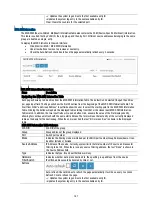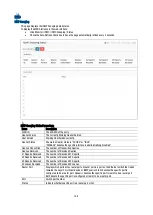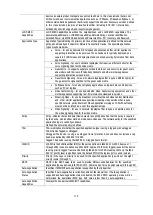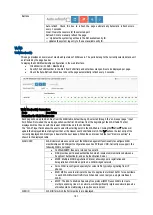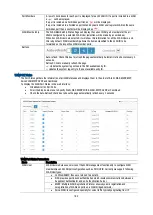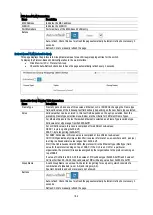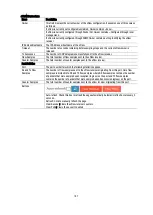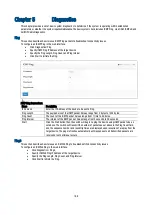
174
LLDP MED Neighbor
This page provides a status overview of all LLDP-MED neighbors. The displayed table contains a row for each port on
which an LLDP neighbor is detected. This function applies to VoIP devices which support LLDP-MED.
To display the LLDP Neighbor Information in the web interface:
Click Monitor / LLDP / LLDP-MED Neighbors
Check the Auto-Refresh check box to have the page automatically refresh every 3 seconds.
Note: If the network has no LLDP-MED supported devices it will display ‘No LLDP-MED neighbor information found.
LLDP Neighbor Information Parameters:
Items
Description
Port
The port on which the LLDP frame was received.
Device Type
LLDP-MED Devices are comprised of two primary Device Types: Network Connectivity.
Devices and Endpoint LLDP-MED Network Connectivity Devices, as defined in TIA-1057, provide access to the IEEE 802
based LAN infrastructure for LLDP-MED Endpoint Devices. An LLDP-MED Network Connectivity Device is a LAN access
device based on any of the following technologies:
Lan Switch/Router
IEEE 802.1 Bridge
IEEE 802.3 Repeater (included for historical reasons)
IEEE802.11 Wireless Access Point.
Any device that supports the IEEE 802.1AB and MED extensions defined by TIA-1057 and can
relay IEEE 802 frames via any method.
LLDP-MED Endpoint Devices, as defined in TIA-1057, are located at the IEEE 802 LAN network edge, and participate in
IP communication service using the LLDP-MED framework.
Within the LLDP-MED Endpoint Device category, the LLDP-MED scheme is broken into
further Endpoint Device Classes, as defined in the following. Each LLDP-MED Endpoint Device
Class is defined to build upon the capabilities defined for the previous Endpoint Device Class.
For-example any LLDP-MED Endpoint Device claiming compliance as a Media Endpoint
(Class II) will also support all aspects of TIA-1057 applicable to Generic Endpoints (Class I),
and any LLDP-MED Endpoint Device claiming compliance as a Communication Device (Class
III) will also support all aspects of TIA-1057 applicable to both Media Endpoints (Class II) and
Generic Endpoints (Class I).
LLDP-MED Media
Endpoint Class I
Class I: The LLDP-MED Generic Endpoint (Class I) definition is applicable to all endpoint
products that require the base LLDP discovery services defined in TIA-1057, however do not
support IP media or act as an end-user communication appliance. Such devices may include
(but are not limited to) IP Communication Controllers, other communication related servers, or
any device requiring basic services as defined in TIA-1057. Discovery services defined in this
class include LAN configuration, device location, network policy, power management, and
inventory management.
LLDP-MED Media
Endpoint Class II
Class II: The LLDP-MED Media Endpoint (Class II) definition is applicable to all endpoint
products that have IP media capabilities however may or may not be associated with a
particular end user. Capabilities include all of the capabilities defined for the previous Generic
Endpoint Class (Class I), and are extended to include aspects related to media streaming.
Example product categories expected to adhere to this class include (but are not limited to)
Voice / Media Gateways, Conference Bridges, Media Servers, and similar. Discovery services
defined in this class include media-type-specific network layer policy discovery.
LLDP-MED Media
Endpoint Class III
The LLDP-MED Communication Endpoint (Class III) definition is applicable to all endpoint
products that act as end user communication appliances supporting IP media. Capabilities
include all of the capabilities defined for the previous Generic Endpoint (Class I) and Media
Endpoint (Class II) classes, and are extended to include aspects related to end user








